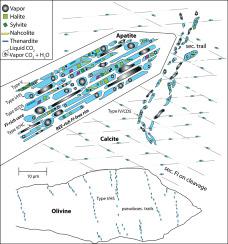Earth-Science Reviews ( IF 10.8 ) Pub Date : 2021-01-09 , DOI: 10.1016/j.earscirev.2021.103509 Benjamin F. Walter , R. Johannes Giebel , Matthew Steele-MacInnis , Michael A.W. Marks , Jochen Kolb , Gregor Markl

|
Carbonatites are formed from volatile-rich melts, commonly associated with a characteristic hydrothermal footprint. However, studies of their fluid inclusions are relatively scarce and heterogeneous in terms of detail and completeness of the data presented. Here, we review and discuss comprehensively the results of previous studies and derive a general model for the formation and properties of fluids associated with carbonatitic magmatism.
Worldwide, four types of fluid inclusion occur in carbonatites: (type I/HS) vapour-poor H2O-NaCl fluids with up to 50 wt% salinity; (type II/HC) vapour-rich H2O-NaCl-CO2 fluids with <5 wt% salinity; (type III/DS) multi-component fluids with high salinity and without CO2; and (type IV/CDS) multi-component fluids with high salinity and high CO2. This global dataset suggests continuous fluid release from deep to shallow-level intrusions. Modelling of the liquidus surface indicates that carbonatite magmas generally exsolve a saline brine (type I/HS). This brine separates/evolves into a Na-K-sulfate-carbonate/bicarbonate-chloride brine with or without CO2 (types III/DS and IV/CDS), trapped together with low salinity CO2-rich fluids produced by immiscibility.
Fluid immiscibility is related to rapid pressure release during fast, forceful and discontinuous magma ascent, which we envisage as a “pneumatic jackhammer” model for carbonatite ascent and emplacement. In this model, cyclic and progressive fluid flux via pressure build-up and subsequent catastrophic pressure release results in a self-sustaining crustal ascent of the buoyant, low-viscosity magma. This process allows for rapid and efficient magma ascent, in particular above the brittle-ductile transition zone, where pressures that prevailed during apatite crystallization have been estimated in numerous complexes. Moreover, this model provides an explanation for the apparent absence of shallow carbonatite magma chambers (in a classical sense) and identifies fenitization as a phenomenon induced by both fluids released during magma ascent and residual fluids.
中文翻译:

与碳酸盐岩岩浆作用有关的流体:对碳酸盐岩岩浆上升的评论和启示
碳酸盐岩是由富含挥发物的熔体形成的,通常与特征性的热液足迹有关。然而,就所提供数据的细节和完整性而言,对它们的流体包裹体的研究相对稀少且不均一。在这里,我们全面回顾和讨论先前研究的结果,并得出与岩性岩浆作用有关的流体的形成和性质的通用模型。
在全球范围内,碳酸盐岩中存在四种类型的流体包裹体:(I / HS型)贫盐的H 2 O-NaCl流体,盐分含量高达50 wt%;(II / HC型)盐分<5 wt%的富含蒸气的H 2 O-NaCl-CO 2流体;(III / DS型)高盐分且无CO 2的多组分流体;高盐度和高CO 2的(IV / CDS型)多组分流体。这个全球数据集表明,从深部侵入到浅部侵入的流体持续释放。液相线表面的模型表明,碳酸盐岩岩浆通常会溶解盐水(I / HS型)。该盐水分离/演化为有或没有CO 2的Na-K-硫酸盐-碳酸盐/碳酸氢盐-氯化物盐水(III / DS型和IV / CDS型),与不混溶性产生的低盐度富含CO 2的流体一起捕集。
流体不混溶与快速,有力和不连续的岩浆上升过程中的快速压力释放有关,我们将其设想为碳酸盐岩上升和就位的“气动风炮”模型。在该模型中,通过压力积累和随后的灾难性压力释放而产生的循环和渐进式流体通量会导致浮力低粘度岩浆的地壳上升。该过程允许快速且有效的岩浆上升,特别是在脆性-延性过渡区上方,在该处,磷灰石结晶过程中普遍存在的压力已在许多复合物中进行了估算。而且,











































 京公网安备 11010802027423号
京公网安备 11010802027423号